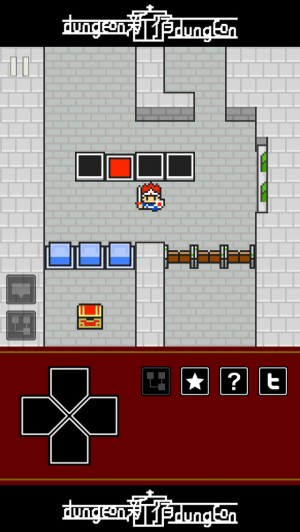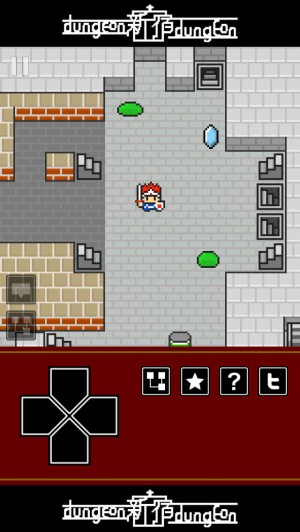 One of the cool things about indie games is that concepts that literally have no chance of getting greenlit via traditional means can still find a way to get out there. Everything from inside jokes to personal stories to insanely specific niches can all become games for the world to see and play. Shinjuku Dungeon (Free), from one-man developer Uehara Labo, is a great example of this. On the one hand, it’s a very typical retro-styled adventure that has you exploring a winding labyrinth, solving a variety of puzzles, and collecting keys and items that allow you to open up new areas. On the other hand, it’s a nearly perfect recreation of a real place that tens of thousands of people walk through every day. While the game itself is decent enough, it’s certainly nothing special. Yet, for anyone familiar with the real place, Shinjuku Dungeon takes on a whole new meaning.
One of the cool things about indie games is that concepts that literally have no chance of getting greenlit via traditional means can still find a way to get out there. Everything from inside jokes to personal stories to insanely specific niches can all become games for the world to see and play. Shinjuku Dungeon (Free), from one-man developer Uehara Labo, is a great example of this. On the one hand, it’s a very typical retro-styled adventure that has you exploring a winding labyrinth, solving a variety of puzzles, and collecting keys and items that allow you to open up new areas. On the other hand, it’s a nearly perfect recreation of a real place that tens of thousands of people walk through every day. While the game itself is decent enough, it’s certainly nothing special. Yet, for anyone familiar with the real place, Shinjuku Dungeon takes on a whole new meaning.
 The game looks like an 8-bit RPG, Dragon Quest to be very specific, and certain areas look very much like a dungeon. The floor map, however, is almost a pitch-perfect replica of Shinjuku Station in Tokyo, one of the busiest train stations in the world, and famous among Japanese for being one of the most confusingly-designed structures around today. It’s a multi-floor, sprawling place, interconnected with many other buildings and shops, with tons of exits, winding passages, and a design with seemingly little regard for convenience or order. Little wonder, then, that local gamers refer to it as the Dungeon of Tokyo. Shinjuku Dungeon amusingly adds some order to the place by placing obstacles, gates, puzzles, and keys in such a way that there is a somewhat linear route through the place, but it lets the actual floor plan speak for itself. Playing it from the typical bird’s-eye-view of classic RPGs, it’s hard to argue against it being set up like a nefarious maze of doom.
The game looks like an 8-bit RPG, Dragon Quest to be very specific, and certain areas look very much like a dungeon. The floor map, however, is almost a pitch-perfect replica of Shinjuku Station in Tokyo, one of the busiest train stations in the world, and famous among Japanese for being one of the most confusingly-designed structures around today. It’s a multi-floor, sprawling place, interconnected with many other buildings and shops, with tons of exits, winding passages, and a design with seemingly little regard for convenience or order. Little wonder, then, that local gamers refer to it as the Dungeon of Tokyo. Shinjuku Dungeon amusingly adds some order to the place by placing obstacles, gates, puzzles, and keys in such a way that there is a somewhat linear route through the place, but it lets the actual floor plan speak for itself. Playing it from the typical bird’s-eye-view of classic RPGs, it’s hard to argue against it being set up like a nefarious maze of doom.
The goal of Shinjuku Dungeon is to collect all of the jewels hidden around the station. There’s a sub-goal of checking in at every check-in spot on the map, as well. The way the game plays out is something like a cross between Legend of Zelda and Metroid. Like in Zelda, you’ll sometimes need to solve puzzles like pushing blocks or flipping switches to open doors or clear the way to treasure chests. The actual design of the obstacles is set up like Metroid, though, with one large inter-connected map that is initially only partly navigable. Collecting items and keys will gain you access to new areas which will contain new keys and items that will let you open up another area you couldn’t reach before. Although you might expect it from looking at screenshots, there’s no actual combat in the game. Enemies are impassable objects that can’t kill you but will bounce you back if you move into them. Moving past them requires the right item, so they’re really just a different-shaped locked door.
As such, your input is limited simply to moving around, which is accomplished by a virtual directional pad. Other buttons allow you to bring up a map screen, overlay a transparent map onto the gameplay field, check your goal progress, and view your items. The interface takes up a good chunk of the screen, and, as the game is free and has no IAP, ads take up a few other bits. The claustrophobic viewing area actually works well for the atmosphere the game seems to be going for, though. The puzzles are quite varied, including sokoban-style block-pushing, sliding tile puzzles, making your way through corridors lined with invisible pit traps, lights on-lights off puzzles, and more. It’s all stuff you’ve seen before if you’ve played a few puzzle games, but it’s still pleasant to see such a nice mix of puzzles instead of simply relying on one or two types.
 The game can be finished in a couple of hours once you know where to go, but since the jewels are sometimes well-hidden or hard to spot and the dungeon itself is so big and confusing, it might take you longer. There’s no time limit nor is there any way to die, so it’s kind of a mellow tour through a puzzle-filled recreation of a real location. If you really want to take it easy, the game offers a free play mode that lets you simply walk around where you like in the station, with all of the obstacles removed. There’s a Game Center leaderboard that tracks your completion percent, but tons of people have 100% already, so it’s not really a great game for competing on.
The game can be finished in a couple of hours once you know where to go, but since the jewels are sometimes well-hidden or hard to spot and the dungeon itself is so big and confusing, it might take you longer. There’s no time limit nor is there any way to die, so it’s kind of a mellow tour through a puzzle-filled recreation of a real location. If you really want to take it easy, the game offers a free play mode that lets you simply walk around where you like in the station, with all of the obstacles removed. There’s a Game Center leaderboard that tracks your completion percent, but tons of people have 100% already, so it’s not really a great game for competing on.
Shinjuku Dungeon isn’t a particularly deep game, and it isn’t mechanically exciting. Instead, it is simply an interesting game, a bizarre fusion of reality and fantasy, filtered through the perspective of a developer who clearly holds 8-bit adventure and RPG games very near and dear to his heart. I enjoyed slowly picking my way through it, making progress on my completion percentage little by little, and pulling back the layers of the map. Of course, my familiarity with the source might have added to my enjoyment somewhat, but I think even without that, there’s no harm in trying it out, especially if you like relaxed puzzle games. At the very least, if anyone catches you playing it, you can claim it’s educational.